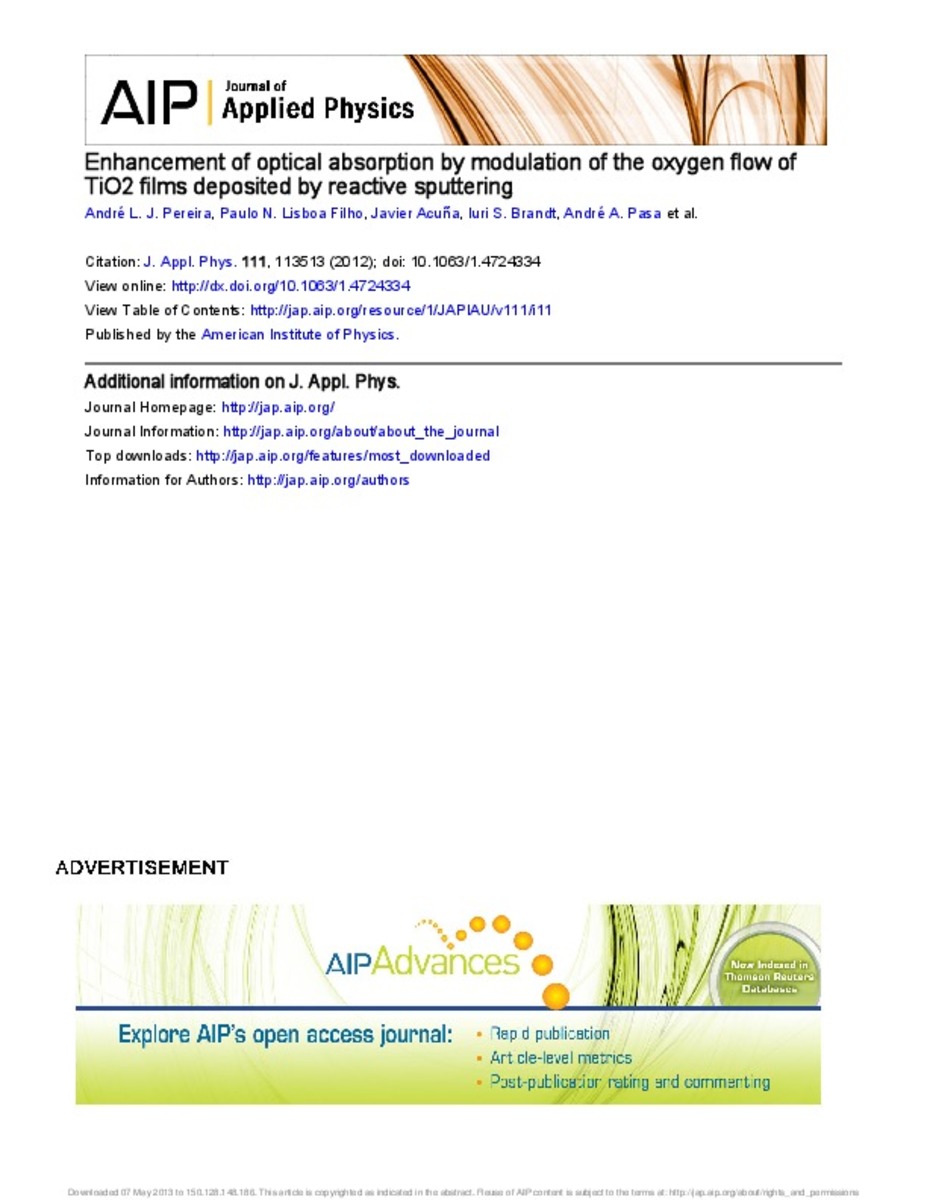Mostrar el registro sencillo del ítem
Enhancement of optical absorption by modulation of the oxygen flow of TiO2 films deposited by reactive sputtering
| dc.contributor.author | Beltran, Armando | |
| dc.contributor.author | Pereira, André L. J. | |
| dc.contributor.author | Lisboa Filho, Paulo N. | |
| dc.contributor.author | Acuña, Javier | |
| dc.contributor.author | Brandt, Iuri S. | |
| dc.contributor.author | Pasa, André A. | |
| dc.date.accessioned | 2013-05-07T16:03:41Z | |
| dc.date.available | 2013-05-07T16:03:41Z | |
| dc.date.issued | 2012 | |
| dc.identifier.citation | J. Appl. Phys. 111, 113513 (2012) | ca_CA |
| dc.identifier.issn | 0021-8979 | |
| dc.identifier.issn | 1089-7550 | |
| dc.identifier.uri | http://hdl.handle.net/10234/62692 | |
| dc.description.abstract | Oxygen-deficient TiO2 films with enhanced visible and near-infrared optical absorption have been deposited by reactive sputtering using a planar diode radio frequency magnetron configuration. It is observed that the increase in the absorption coefficient is more effective when the O2 gas supply is periodically interrupted rather than by a decrease of the partial O2 gas pressure in the deposition plasma. The optical absorption coefficient at 1.5 eV increases from about 1 102 cm 1 to more than 4 103 cm 1 as a result of the gas flow discontinuity. A red-shift of 0.24 eV in the optical absorption edge is also observed. High resolution transmission electron microscopy with composition analysis shows that the films present a dense columnar morphology, with estimated mean column width of 40 nm. Moreover, the interruptions of the O2 gas flow do not produce detectable variations in the film composition along its growing direction. X-ray diffraction and micro-Raman experiments indicate the presence of the TiO2 anatase, rutile, and brookite phases. The anatase phase is dominant, with a slight increment of the rutile and brookite phases in films deposited under discontinued O2 gas flow. The increase of optical absorption in the visible and near-infrared regions has been attributed to a high density of defects in the TiO2 films, which is consistent with density functional theory calculations that place oxygen-related vacancy states in the upper third of the optical bandgap. The electronic structure calculation results, along with the adopted deposition method and experimental data, have been used to propose a mechanism to explain the formation of the observed oxygen-related defects in TiO2 thin films. The observed increase in sub-bandgap absorption and the modeling of the corresponding changes in the electronic structure are potentially useful concerning the optimization of efficiency of the photocatalytic activity and the magnetic doping of TiO2 films. | ca_CA |
| dc.format.extent | 12 p. | ca_CA |
| dc.format.mimetype | application/pdf | ca_CA |
| dc.language.iso | eng | ca_CA |
| dc.publisher | American Institute of Physics (AIP) | ca_CA |
| dc.relation.isPartOf | Journal of Applied Physics, num. 111 | ca_CA |
| dc.rights | Copyright 2012 American Institute of Physics | ca_CA |
| dc.rights.uri | http://rightsstatements.org/vocab/InC/1.0/ | * |
| dc.title | Enhancement of optical absorption by modulation of the oxygen flow of TiO2 films deposited by reactive sputtering | ca_CA |
| dc.type | info:eu-repo/semantics/article | ca_CA |
| dc.identifier.doi | http://dx.doi.org/10.1063/1.4724334 | |
| dc.rights.accessRights | info:eu-repo/semantics/openAccess | ca_CA |
| dc.relation.publisherVersion | http://scitation.aip.org/getpdf/servlet/GetPDFServlet?filetype=pdf&id=JAPIAU000111000011113513000001&idtype=cvips&doi=10.1063/1.4724334&prog=normal | ca_CA |
| dc.type.version | info:eu-repo/semantics/publishedVersion | ca_CA |
Ficheros en el ítem
Este ítem aparece en la(s) siguiente(s) colección(ones)
-
QFA_Articles [812]
Articles de publicacions periòdiques







